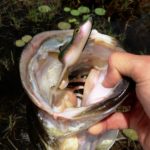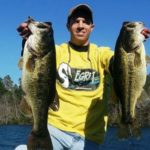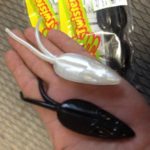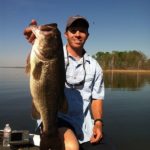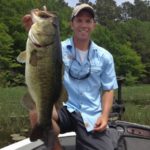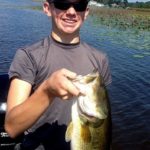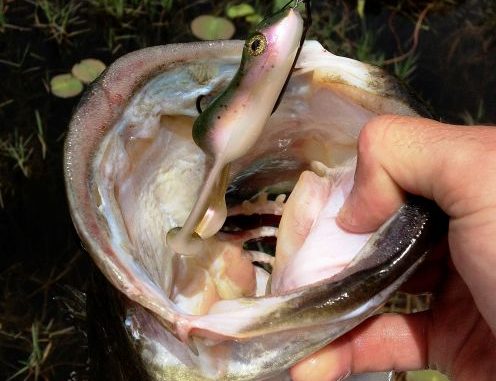
There’s more to spring bass fishing on Toledo Bend than picking lunkers off their beds. It’s also the perfect time to fish with plastic frogs, and these experts tell you how.
In Grimm’s Fairy Tales there is a story about a princess who made a deal with a frog who had secured her lost golden ball from the depths of a well.
All the frog asked in return was for the princess to love him, entertain him and let him be her constant companion.
The princess agreed, but once the ball was returned, she suddenly jumped up and returned to the castle without the creature.
The frog responded by visiting her castle and eventually gaining entrance. The king, upon hearing the terms of the deal, encouraged the princess strongly to make good her promise since she had given the medieval amphibian her word.
Let’s just say the princess came through, although she remained horribly disgusted by the frog’s continued appearance and odor. She begrudgingly obeyed her father.
Once the deal was done, the frog turned into a wonderfully handsome and rich prince. He then told the princess and king his story of a wicked witch cursing him by transforming him into a frog.
Of course, the prince and princess rode off in his custom carriage after a marriage ceremony and lived happily ever after.
What does this fairy tale have to do about bass fishing on Toledo Bend?
During the spring and summer of 2013, Toledo Bend bass anglers were also enchanted but not by any witch.
Artificial frogs were both the culprits and all the rage, resulting in stringers of hefty largemouth bass — particularly in the reservoir’s southern waters.
But, unlike the princess in the fairy tale, anglers like Johnny Watkins of Sulphur and Jason Pittman of Covington didn’t have any problem keeping their frogs as constant companions.
In February 2013, 36-year-old Watkins began throwing Stanley Jig’s melon/red pearl Top Toads wherever he could find the beginnings of grass matted edging on points in Toledo Bend south.
“I was just casting the Top Toad into the grass sticking out near points when it got bit,” he said.
Of course, he had to work the fish to the top and through the cover to get it to the boat.
The end result was an 8- pounder.
“I caught a few other bass in the 4- to 5- pound range on another point with submerged grass,” the angler said.
A little later he cast the frog on top again and a fish swirled at it.
“I cast it again and let it sit in a pocket just a couple of seconds, and it was inhaled by a 6-pounder,” Watkins said. “I had a great stringer of bass well over 20 pounds that day.”
Watkins said he and others had started taking hefty bass on the Top Toad in February on the main lake and near secondary points.
“Those fish were prespawners that were staging and feeding before moving onto the beds,” Watkins said. “I don’t think a lot of people realize how early a big bass will hit a topwater — especially if we get two to three days of warm weather.”
In February and throughout March, Watkins concentrates on the first 50 yards on both sides of points that have good outside grass lines.
“March was more of the same, big bass upwards of 8 pounds taken, and some of the bass were already post-spawners,” he said.
Watkins said the topwater toad bite continued into May as more and more bass headed out of their spawning pockets and staged to feed before moving into deeper waters.
That was proven in early April, when Watkins and fishing buddy Lance Melendy were fishing the Indian Mounds.
“Our five largest bass taken that day went over 26 pounds,” Watkins said. “I had taken a 5-pounder at 2 p.m., followed up by a 6 ½-pounder on the Top Toad on top of some grass in the area.
Later that afternoon, Watkins was fishing a combination of haygrass and green grass when another fish blew up on the Top Toad.
“She jumped out of the water, and I could see she was really big,” he said. “She stayed wrapped around a stump for seven to eight seconds, and I eased up and let her work her way around it.
“After making two more runs, Lance was able to net her.”
The sow weighed 9.1 pounds, and marked the third bass he had landed that surpassed the 8-pound mark.
Thirty-seven-year-old Jason Pittman of Covington, a tournament bass angler with a residence on the Texas side of Toledo Bend, was also busy catching hefty stringers on Mr. Twister’s Hawg Frog and the Jerk Rat last spring.
“It was in April when I started catching a good many quality bass on these lures,” he said. “I was working grass and enjoyed a great early morning bite that extended into the daylight hours. In a very short period of time I had 10 to 15 bass that weighed 4 ½ pounds or better.”
Pittman said the frog bite is much more than an early morning affair.
“One great advantage of throwing Hawg Frogs and Jerk Rats is that this bass bite will extend into the daylight areas, as the bass will get well into the cover of the grass and under lily pads to hide from the sun,” he explained.
Watkins agreed.
“They’ll eat that toad all day,” he said. “The first hour, of course, is better, but when it starts warming up about mid-morning, the bass will seek cover from the sun in the grass.
“That puts them in place like under lily pads, and that really helps you target them with toads and frogs. That’s also when that pause on the Top Toad — which stays on top —really helps the angler.”
How to work the toads, frogs and the rat
Johnny Watkins has a lot of experience casting frog lures. When he was younger, he admittedly spent much time fishing the pools in the Lacassine National Wildlife Refuge with its abundant emergent and submerged vegetation.
However, different versions of frogs offer different advantages.
“I’ll use the Ribbit when I need a little more noise on the water,” Watkins said. “But I find when the Ribbit sinks in the holes and pockets, the mid-day bass bite tapers off.”
He mainly fished Stanley Jigs’ Ribbits back then, so changing up to Stanley’s new Top Toad that premiered last February was an easy transition.
One of the most-crucial aspects of successfully fishing frogs is using tackle that is sensitive but stout enough to keep pressure on fish so they can’t bury into the grass.
“I will throw the Top Toad and the Ribbit on a 7-foot heavy/fast-action Shimano Crucial rod,” Watkins said. “To deal with the heaviness of the fish as well as the grass, I also will have 65-pound PowerPro braid.”
Jason Pittman’s Hawg Frog and Jerk Rat tackle setup is similar to that of Watkins’.
“I use an Abu Garcia 7 ½-foot medium/heavy Veritas rod with a fast-action tip,” Pittman said. “It has good backbone, and I can lean on it when taking bass out of the vegetation.”
Heavy line also is part of his equation.
“When fishing the Hawg Frog and the Jerk Rat, I’ll have 60-pound FINS XS braid spooled on my reel,” he said.
As for hooks, Watkins has become fond of using Stanley Jigs’ Double-Take hooks.
“Bass will often aggressively bite topwater frogs, but sometimes they just don’t get hooked,” he said. “The Double-Take hook’s design is actually two hooks attached to one shaft, increasing the probability of a hookup. It has a longer shaft with those two hooks that attach easily to the top body of the Top Toad or Ribbit. It doubles your chances and ensures that the bass stay on better, especially if they are wrapped around with vegetation.”
Pittman casts the Hawg Frog with lighter hooks, his mainstay being a 3/0 extra-wide Gamakatsu. As for the Jerk Rat, he’ll use a 5/0 and/or 4/0 Gamakatsu.
Watkins said anglers shouldn’t just aimlessly throw a topwater frog.
“Pay attention to where you are throwing it,” he said. “Look at exactly where and how you get blow-ups. If you get enough bites to get a pattern going, you can duplicate this at other points and in creeks, as well.”
An example of this occurred last Mother’s Day, when Watkins and wife Sara, along with sons Kade and Garrett, made a family bream-fishing trip together on south Toledo Bend.
With 60 nice bream already in the boat, Watkins noticed big swirls in the grass and nearby lily pads. He couldn’t resist the opportunity.
“I told Sara to cast a Top Toad over where the action was, and she hooked and hauled in an 8-pounder,” he said. “An hour later I saw another swirl to the side, and I cast the toad there and ended up with a 9- pounder.
“That Mother’s Day was the best fishing trip my family ever experienced together.”
Pittman said he keeps his trolling motor on to increase his odds of crossing paths with a bass.
“Although about everyone has their own method, I personally cover a lot of water with the Hawg Frog,” Pittman said. “It’s a subtle frog and they cause a reaction bite I think, and if they miss I’ll slow it down.
“I also enjoy twitching them like a Spook, sort of a dogwalking routine, constantly twitching it and keeping the baits erratic.”
He said the Jerk Rat is made for working over vegetation.
“The Jerk Rat’s design allows it to be pulled over the weeds and sort of slither through the vegetation,” Pittman said. “It works well when jerked through erratically.
“It’s sort of a finesse bait.”
